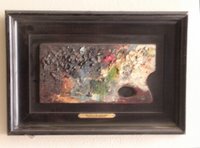The Palette and Chisel Modernists
 "Parade of Chicago Artists to the No-Jury Artists Cubist Ball" - 1923
"Parade of Chicago Artists to the No-Jury Artists Cubist Ball" - 1923The Palette and Chisel has never been
especially academic,
either 100 years ago when that meant Renaissance/Classical
or today when academic means conceptual/transgressive,
but neither has it been strongly identified
with whatever could be called Modernism
except for a brief period 1915-1920
when three of Chicago's pioneering modernists
were members of the club.
Regretfully, there was some dispute over whether
a certain painting should be juried into a P&C exhibit,
the modernists vetoed it but were over-ruled,
and they quit in bitter protest,
and began their own No-Jury Society.
It doesn't make a lot of sense,
and that society didn't last very long,
but they were all kind of young and wild in those days.
 Carl Hoeckner
Carl Hoeckner"conceals behind the most amiable of
bourgeois personalities and the handsomest
of rotund German masks, the presidency of the
Heaven annointed Int'l Brotherhood of Cor-Ardens
(bleating hearts), and a predilection for black gloomy
visions with horrible emaciated figures."
(the Cor-Ardens was a another new art club of the time,
but it only lasted about a year or two)
 Ramon Shiva
Ramon Shiva"The fiery sputtering Spanish Valentino
has a family - but also supports them.
Uses gorgeous colors gorgeously"
(he was also a trained chemist
who developed the Shiva brand of Oil paints)
 Rudolph Weisenborn
Rudolph Weisenborn"Chief poo-bah or Trotzky of the insurgents.
Instigator and President of the No-Jury Society.
His first masterpiece covered sixty-three square feet
including the frame,and was covered with $10,000.00
worth of paint. After a series of portentous portraits
in charcoal, he is devoting the next 10 years to a
second masterpiece"
In the history of modern art in Chicago,
these are the only P&C members worthy of mention,
but even today,
when Modern Art has been canonical for almost 80 years,
the cash value of their paintings is negligible
compared to their more conservative colleagues.
A Weisenborn self-portrait, for example,
recently sold at auction for $400,
while an Edgar Payne mountain landscape
went for $130,000.
(more about these three fellows will be presented later)


3 Comments:
YOUR ASSISTANCE PLEASE!!
In the upper right corner of the poster there is an image of a woman holding a bomb - with the name HELEN WEST HELLER. . .
Can someone tell me what the words are on her skirt??
She is my favorite Chicago artist - and I have a website on her members of This Old Palette might enjoy. . .
Her skirt reads:
HELLen West HELLer
One of our most underappreciated
Geniuses is trying to live up to
Her name, came so near
to upseetting the parade that the
parade has apparently
upset her
.......................
Thanks for the link to your site, and the introduction to this fascinating woman
Thanks Chris for explaining what is on Heller's skirt. . . glad you enjoyed the link to my website on Helen West Heller. Maybe you will consider adding to this blog. Anyway, I appreciate your assistance. All the best
Post a Comment
<< Home